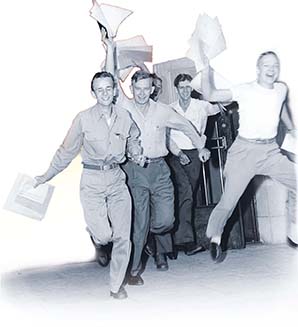SECTION 1: An Economic Boom

▼ Returning veterans, aided by the GI Bill of Rights, filled university classrooms.
WITNESS HISTORY  AUDIO
AUDIO
The GI Bill of Rights
Passed in 1944, the Serviceman’s Readjustment Act, known as the GI Bill of Rights, was intended to ease the soldier’s transition from wartime to peacetime. One veteran remembers how the GI Bill affected his life:
“You were able to go to any school that accepted you … So I … found the best school that I [could] go to, regardless of tuition, which was Columbia in New York, and they accepted me. I graduated [with] a Bachelor of Science in Business Administration and they accepted me into the Master’s program in business at Columbia and I was amazed that [the government] paid the entire tuition…. [It] was a revolution that all these people, who never would go to college, went to college because of the GI Bill.”
—Interview with Harvey S. Lowy, Rutgers Oral History Archives of World War II
Objectives
- Describe how the United States made the transformation to a peacetime economy.
- Discuss the accomplishments of Presidents Harry Truman and Dwight Eisenhower.
- Analyze the 1950s economic boom.
Terms and People
- demobilization
- GI Bill of Rights
- baby boom
- productivity
- Taft-Hartley Act
- Fair Deal
NoteTaking
Reading Skill: Understand Effects List the problems raised by the shift to a peacetime economy and the steps taken to solve them.
Why It Matters After World War II, many Americans worried that the war’s end would bring renewed economic depression. Numerous economists shared this pessimistic view of the future, predicting that the American economy could not produce enough jobs to employ all those who were returning from the military. Yet, instead of a depression, Americans experienced the longest period of economic growth in American history, a boom that enabled millions of Americans to enter the middle class. This era of sustained growth fostered a widespread sense of optimism about the nation’s future. Section Focus Question: How did the nation experience recovery and economic prosperity after World War II?
The Nation Recovers From War
At the end of the war in August 1945, more than 12 million Americans were in the military. Thousands of American factories were churning out ships, planes, tanks, and all the materials required to help fight the war in the Pacific. Virtually overnight, both the need for such a huge military machine and the focus on war production came to an end. Orders went out from Washington, D.C., canceling defense contracts, causing millions of defense workers to lose their jobs. Wartime industries had to be converted to meet peacetime needs.





